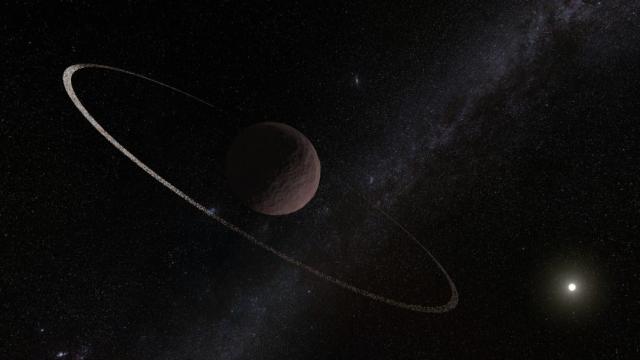Researchers observing a background star pass behind Quaoar, a dwarf planet in the Kuiper belt, found that the distant object has a ring system unlike any previously found in our solar system.
The team did not directly observe the ring system; they detected it due to the way light behind Quaoar dimmed as the planetoid passed in front of it. The dwarf planet, discovered back in 2002, takes 288 years to complete an orbit around the Sun. The team’s research is published today in Nature.
According to the Planetary Society, ring systems can form in a couple of ways. They form around planets when the latter’s gravitational force tears up smaller bodies around it, such as moons. Others, like Jupiter’s, are formed by dust particles that are kicked up from the planet’s moons by micrometeoroid impacts.
“Everyone learns about Saturn’s magnificent rings when they’re a child, so hopefully this new finding will provide further insight into how they came to be,” said Vik Dhillon, an astronomer at the University of Sheffield and co-author of the paper, in a university release.
HiPERCAM — a camera on the 10.36 m-wide Gran Telescopio Canarias in Spain — captured the ring system during an occultation event.
When Quaoar (pronounced kwa-wahr) passed in front of the background star, the star’s light dimmed thrice — once during the occultation itself, but also briefly before and after. That indicated to researchers that there is a mass on either side of the dwarf planet; they believe it to be a ring system far flung from the planetoid itself.
While the ring system itself is interesting, the distance from Quaoar at which it sits is astonishing, circling at more than seven times the radius of the dwarf planet. By contrast, Saturn’s main rings are within just three planetary radii from the luminous gas giant. At about 690 miles (1,100 kilometers) wide, Quaoar is a bit under half the size of Pluto.
“It was doubly unexpected to find the rings so far out from Quaoar, challenging our previous notions of how such rings form,” Dhillon said.
More observations of Quaoar’s system may shed light on its composition and origins. Quaoar has now pushed the boundaries of what astronomers thought ring structures could look like; it’s incumbent on other celestial bodies to show us if Quaoar is part of a rule or an exception.
